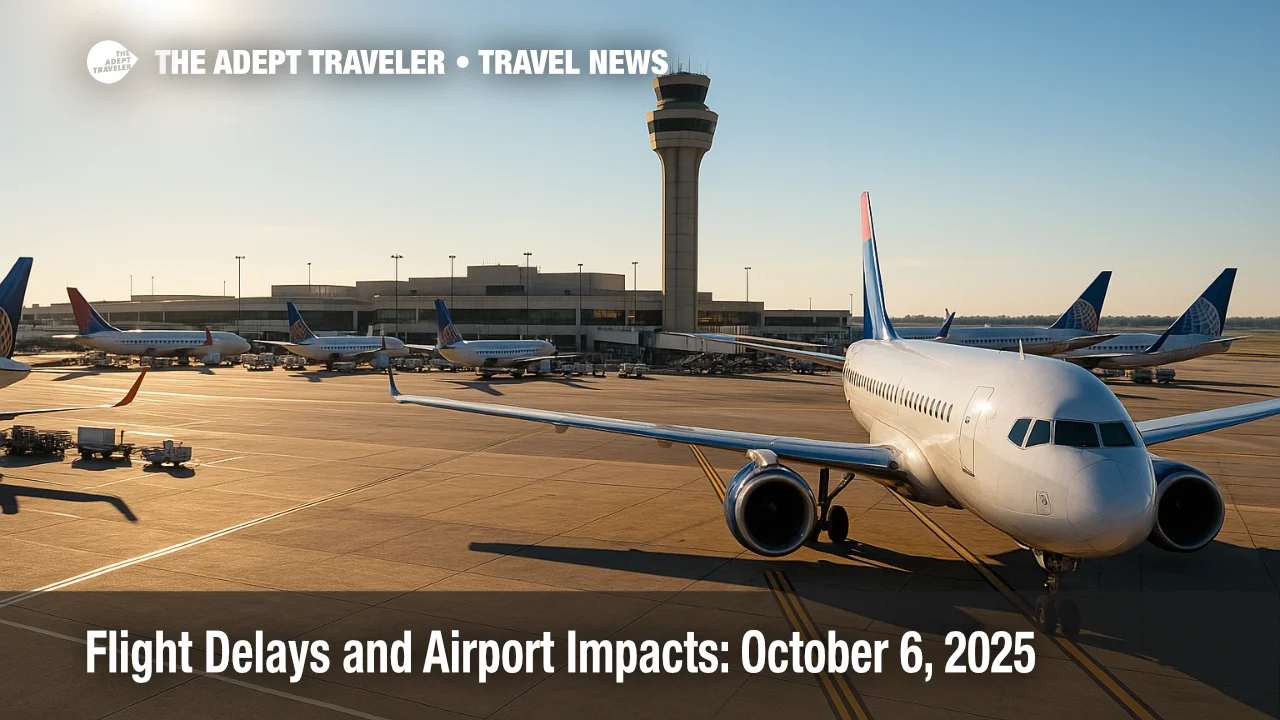Flight delays and airport impacts: October 6, 2025

The FAA expects a busy operational picture with multiple weather and construction constraints. Boston Logan International Airport (BOS) is under a collaborative ground delay program this afternoon tied to runway and taxiway work. Low ceilings are forecast around Seattle-Tacoma International Airport (SEA) and Denver International Airport (DEN), while thunderstorms over Florida could disrupt departures and arrivals at Orlando International Airport (MCO), Tampa International Airport (TPA), Miami International Airport (MIA), and Fort Lauderdale-Hollywood International Airport (FLL). Overnight, a SpaceX launch window near Cape Canaveral may prompt short oceanic route restrictions.
Key Points
- Why it matters: BOS has a confirmed ground delay program with average delays near an hour.
- Travel impact: Florida storms and low ceilings at SEA and DEN could trigger pop-up ground stops or programs.
- What's next: Possible routing initiatives this evening, plus oceanic closures tied to a rocket launch window.
- BOS runway construction limits configurations; expect compression during peak banks.
- Chicago hubs could see late-night holds if storms persist along Midwest routes.
Snapshot
The ATCSCC's morning plan flags BOS for a collaborative ground delay program running into the evening due to runway and taxiway constraints. SEA and DEN are highlighted for low ceilings that may warrant programs after the early afternoon push. Florida convection is expected to rattle flows through MCO, TPA, MIA, and FLL, with capping, tunneling, and SWAP routes possible. Route advisories are also on deck for Atlantic, Gulf, and transcon traffic, particularly late day. A SpaceX Starlink launch window just after midnight Eastern may prompt brief oceanic and coastal airspace adjustments. Travelers should monitor airline apps for reflows and gate changes, and leave extra time for connections at BOS, SEA, DEN, and Florida hubs. See yesterday's wrap for lingering effects and strategy shifts. Flight delays and airport impacts: October 5, 2025
Background
Autumn shoulder-season patterns often produce widespread low ceilings in the Pacific Northwest and intermittent storm lines along the Gulf and Florida peninsula. When combined with runway construction at a major hub like BOS, demand frequently outstrips available arrival rates, and the ATCSCC meters traffic with ground delay programs. Today's plan also lists several runway and taxiway projects at large airports, which reduces flexibility when weather pops. Oceanic route closures and special routing advisories are common around launch operations and can ripple to Northeast gateways. For European flyers, note that the French ATC strike slated for October 7 to 9 was suspended, which should reduce transatlantic uncertainty compared with weekend outlooks. France ATC strike for Oct 7-9 suspended
Latest Developments
BOS ground delay program set for the afternoon peak
The most recent advisory sets a BOS CDM ground delay program from 12:10 p.m. EDT, running through the late evening arrival banks. The plan cites runway and taxiway construction with a 38-arrival rate for much of the window and a published average delay of about 55 minutes, capped near 130 minutes. With arrivals on 22L and departures on 22R, expect compression when weather or traffic initiates reroutes into New England. Canadian departures to BOS are included in scope. If you are connecting at BOS, build a buffer and consider earlier inbound options where available. Long-haul flights may see larger holds to stay within the managed arrival rate.
Florida thunderstorms and Northwest low ceilings may trigger programs
The FAA's plan lists thunderstorms impacting Florida departure gates and routes, with possible ground stops or programs for MCO and TPA after mid-afternoon, then potential holds for MIA, FLL, and even Palm Beach International Airport (PBI) into the evening. SEA and DEN carry low-ceiling risk that could justify a ground stop or delay program after the early afternoon banks. Midwest and Texas centers also have thunderstorms in the picture, which may touch Dallas/Fort Worth International Airport (DFW), Dallas Love Field (DAL), and Chicago flows later tonight. Keep an eye on airline notifications for rolling EDCTs and reroutes.
Routing initiatives and rocket launch windows could reshape evening flows
The operations plan includes potential AR and Atlantic Y route closures, transcon and regional reroutes, Gulf route closures, and SWAP escape routes for Central Florida in the late afternoon and evening. Additionally, a Starlink launch window after midnight Eastern may drive short-notice oceanic or coastal procedure changes. None of these measures guarantee delays, but they can lengthen block times and alter gate assignments. Late-night Chicago operations at O'Hare International Airport (ORD) and Chicago Midway International Airport (MDW) could also see arrival-route swaps if convection lingers.
Analysis
Today's constraints illustrate how infrastructure and weather interact. BOS is a prime example: when construction trims runway options, the Command Center imposes a metered arrival rate to keep the airport stable through peaks. A 38-arrival rate with widely sourced demand will inevitably produce holding and EDCTs, and any pop-up weather cuts cushion further. In Florida, scattered storms rarely shut down the system, but they force tactical pauses, reroutes, and missed-approach spacing that accumulate into rolling delays. The Northwest low-ceiling scenario is classic autumn, where ceilings and visibility push terminal rates below demand; if ceilings lift faster than forecast, programs may be canceled mid-push. Finally, launch-related airspace management is short in duration but high in complexity. Expect modest, localized knock-ons for late-night coastal and oceanic flows rather than wholesale cancellations. Travelers booking tight connections at BOS, SEA, DEN, or Florida hubs should consider a longer buffer or earlier departures to reduce misconnect risk.
Final Thoughts
Build flexibility into today's plans if your itinerary touches BOS, SEA, DEN, or Florida. Check your airline app for EDCT updates, monitor gate changes, and leave extra time for security and connections, especially this afternoon through late evening. If you are westbound transcon or crossing the North Atlantic overnight, allow for potential routing drift and slightly longer block times. We will continue to watch for program cancellations if ceilings improve in the Northwest or Florida storms decay earlier than expected, but for now assume modest delays and plan accordingly for flight delays.
